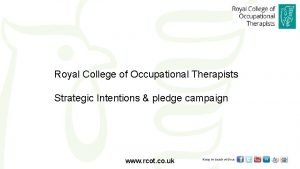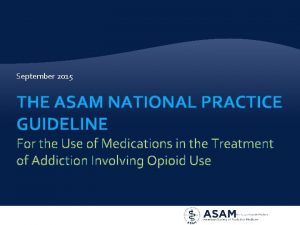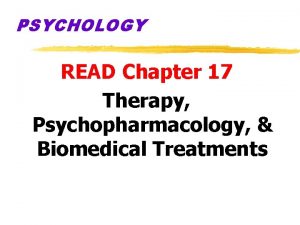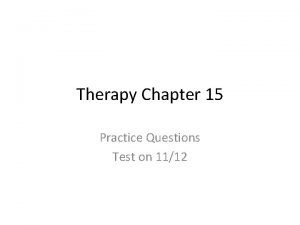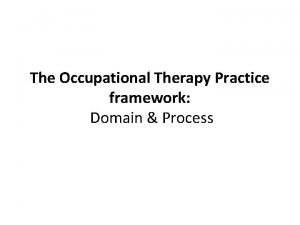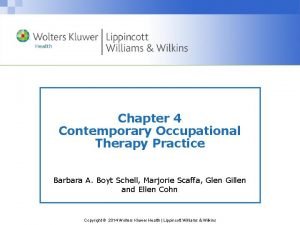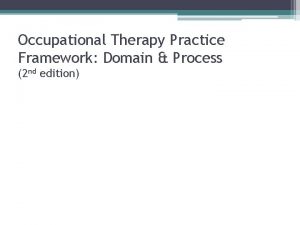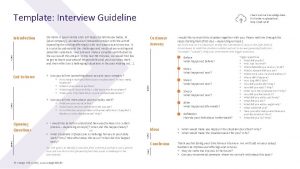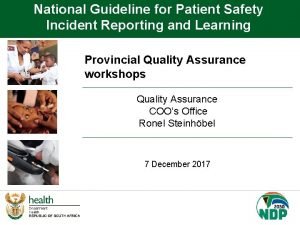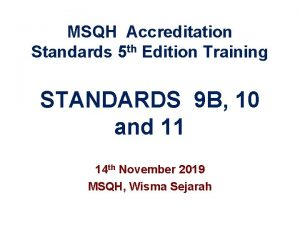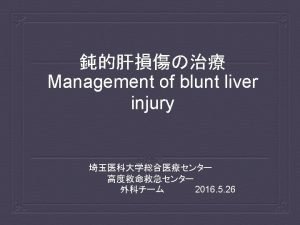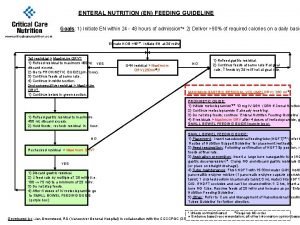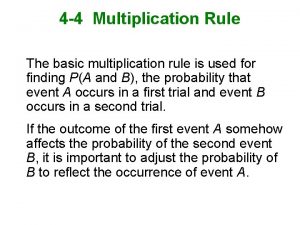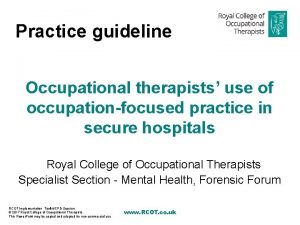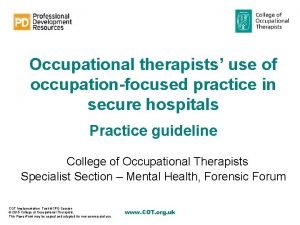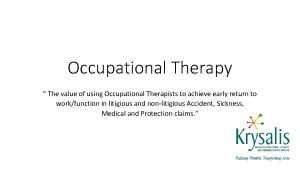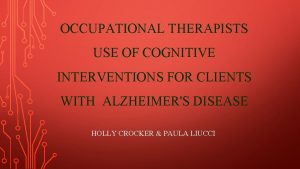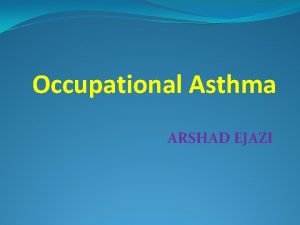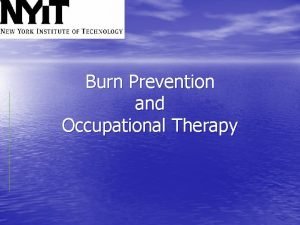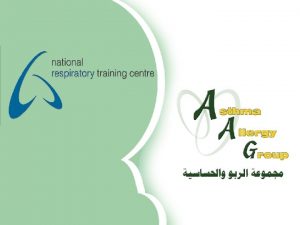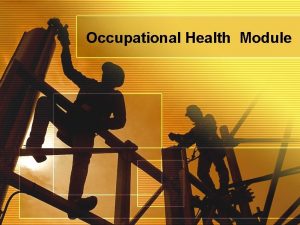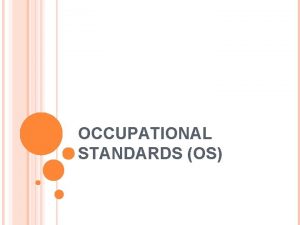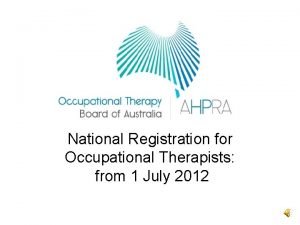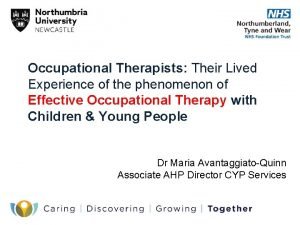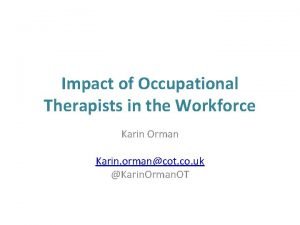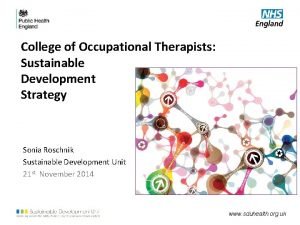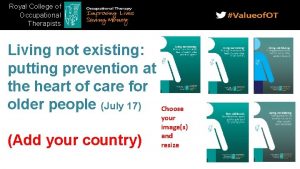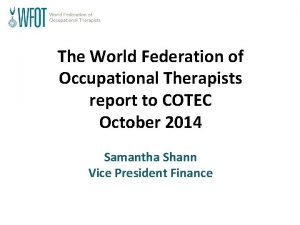Practice guideline Occupational therapists use of occupationfocused practice























- Slides: 23

Practice guideline Occupational therapists’ use of occupation-focused practice in secure hospitals Royal College of Occupational Therapists Specialist Section – Mental Health, Forensic Forum RCOT Implementation Toolkit/CPD Session © 2017 Royal College of Occupational Therapists. This Power. Point may be copied and adapted for non-commercial use www. RCOT. org. uk

Learning outcomes • To explore aspects of the practice guideline recommendations in relation to current practice. • To develop an understanding of the importance of using practice guidelines to inform practice. • To explore and develop an understanding of the RCOT Audit Form available to use with the evidence-based recommendations. RCOT Implementation Toolkit/CPD Session © 2017 Royal College of Occupational Therapists www. RCOT. org. uk 2

Practice question: What evidence is there to support the use of occupation in occupational therapy in secure hospitals with patients over the age of 18? RCOT Implementation Toolkit/CPD Session © 2017 Royal College of Occupational Therapists www. RCOT. org. uk 3

Objective of the guideline To provide specific recommendations to support the use of occupation-focused occupational therapy in secure hospitals. The guideline is relevant to high, medium and secure hospitals. RCOT Implementation Toolkit/CPD Session © 2017 Royal College of Occupational Therapists www. RCOT. org. uk 4

Methodology 2. Guideline scope defined involving stakeholders 1. Guideline development group established 4. Screen findings 5. Critically appraise articles 6. Development of practice guideline recommendations 9. 1 st edition published by COT 2012 10. Review undertaken RCOT Implementation Toolkit/CPD Session © 2017 Royal College of Occupational Therapists 3. Literature search 7. Peer review, stakeholder and service user consultation 8. Final draft approved by COT Practice Publications Group 11. 2 nd edition published by RCOT 2017 www. RCOT. org. uk 5

Evidence-based recommendations Recommendations are based on the evidence available within 41 critically appraised papers. Each recommendation is assigned: • A strength scoring 1 or 2 (Strong or Conditional) • A quality grading A, B, C or D (High, Moderate, Low or Very Low) RCOT Implementation Toolkit/CPD Session © 2017 Royal College of Occupational Therapists www. RCOT. org. uk 6

Recommendation areas Model of Human Occupation Framework: • • Volition Habituation Performance capacity Environmental considerations RCOT Implementation Toolkit/CPD Session © 2017 Royal College of Occupational Therapists www. RCOT. org. uk 7

Volition 1. It is recommended that occupational therapists always take into account the gender-specific needs of patients with whom they are working. 1 C (Baker and Mc. Kay 2001 [C]) 2. It is recommended that occupational therapists consider the occupational life history of patients, including that at the time of the index offence, and its influences on occupational performance, life satisfaction and criminogenic lifestyle. 1 B (Lindstedt et al 2005 [B]) 3. It is recommended that occupational therapists establish, as part of their assessment, patients’ perspectives of their occupational performance and social participation, and work with those perceptions in planning care. 1 B (Lindstedt et al 2004 [B]) RCOT Implementation Toolkit/CPD Session © 2017 Royal College of Occupational Therapists www. RCOT. org. uk 8

Volition contd. Volition 4. It is recommended that occupational therapists work collaboratively with patients to identify and develop care pathways which are recoveryfocused. 1 C (Clarke 2002 [C]; Walker et al 2013 [D]) [Statement amended, new evidence 2017] 5. It is recommended that occupational therapists recognise the specific intrinsic value of occupation to individual patients. 1 C (Craik et al 2010 [C]) 6. It is recommended that occupational therapists facilitate meaningful occupational choices for patients. 1 C (Craik et al 2010 [C]; Cronin-Davies 2010 [C]; Mason and Adler 2012 [C]; Morris 2012 [C]; O’Connell et al 2010 [D]; Stewart and Craik 2007 [C]) 7. It is recommended that occupational therapists ascertain patients’ aspirations towards paid employment at the earliest opportunity, and during rehabilitation. 1 C (Mc. Queen 2011 [C]) RCOT Implementation Toolkit/CPD Session © 2017 Royal College of Occupational Therapists www. RCOT. org. uk 9

Patient perspectives - volition Direct consideration of what interests and enthuses me is important, as it also allows for a good initial relationship and discussion to be individualised Meaningful – Yes, but also relevant to their recovery needs. Activity and progress should be time framed and phased, so progress and skill development can be measured and to ensure things don’t drift, lose meaning and focus ‘Aspirations’ could more specifically relate to a person’s outlook generally rather than only to paid employment Sometimes activities are done to aid independent living skills but repetition leads to boredom and disinterest 10

Habituation 8. It is recommended that occupational therapists consider patients’ roles (past, present and future) within treatment planning and interventions. 1 C (Schindler 2005 [C]) 9. It is recommended that occupational therapy facilitates a range of interventions that enable patients to engage in structured and constructive use of time throughout the week, including weekends and evenings. 1 C (Bacon et al 2012 [D]; Castro et al 2002 [C]; Farnworth et al 2004 [C]; Jacques et al 2010 [D]; Stewart and Craik 2007 [C]) RCOT Implementation Toolkit/CPD Session © 2017 Royal College of Occupational Therapists www. RCOT. org. uk 11

Patient perspectives - habituation It’s really important to help us identify the patterns and history of our engagement and why this is relevant Consider productivity according to past and present – asking patient why this may have differed in order to help us understand the relevance and importance of changed behaviour/engagement Consideration of habituation formed as a result of medication, and /or sleep pattern. Help needed to support patients to work on identifying these patterns in their daily routine and collaborate on how these can be overcome and why breaking them is beneficial to the patient and their recovery 12

Performance capacity 10. It is recommended that occupational therapists routinely used standardised outcome measures to assess and demonstrate patients’ progress. 1 C (Clarke 2003 [D]; Fan 2014 [D]; Fitzgerald 2001 [C]; Green et al 2011 [C]; Kottorp et al 2013 [C]; Mc. Queen 2001 [C]; Williams and Chard 2016 [D]) [New evidence 2017] 11. It is recommended that occupational therapists consider prevocational training, real work, or supported employment as part of occupationbased intervention opportunities for patients. 1 C (Cox et al 2014 [D]; Garner 1995 [D]; Mc. Queen 2011 [C]; Smith et al 2010 [D]; Völlm et al 2014 [D]) [Statement amended, new evidence 2017] RCOT Implementation Toolkit/CPD Session © 2017 Royal College of Occupational Therapists www. RCOT. org. uk 13

Performance capacity contd. Performance capacity 12. It is recommended that occupational therapists consider the use of healthy living programmes and exercise as activity to benefit health and wellbeing. (Bacon et al 2012 [D]; Mc. Queen 2011 [C]; Prebble et al 2011 [D]; Tetlie 1 C et al 2008 [C]; Tetlie et al 2009 [C]; Teychenne et al 2010 [C]) 13. It is suggested that occupational therapists include social inclusion programmes as part of their intervention to improve occupational functioning. 2 C (Fitzgerald 2011 [C]) RCOT Implementation Toolkit/CPD Session © 2017 Royal College of Occupational Therapists www. RCOT. org. uk 14

Patient perspectives – performance capacity Work needed on initial admittance on patients’ fears and anxieties…this is overlooked by staff and in my experience is a barrier for the majority of patients Key for me…and not enough attention paid to [this] in secure care is the identification and appreciation of an individual's past and present skills and qualities. This would help to avoid deskilling and lack of confidence in doing things we used to be very competent at Collaboration with patients to identify methods best used to help them understand/learn and identify their own progress are important…. . Narratives…the importance of these is desperately underestimated… 15

Environmental considerations 14. It is recommended that occupational therapists fully value therapeutic use of self as being integral to the positive engagement of patients in occupations. 1 C (Evans et al 2012 [C]; Mason and Adler 2012 [C]; Tetlie et al 2009 [C]) [Statement amended, new evidence 2017] 15. It is recommended that occupational therapists ensure that risk assessment is a dynamic process, in which judgements are made on an ongoing basis in collaboration with patients and members of the multidisciplinary team. 1 C (Cordingley and Ryan 2009 [C]) 16. It is suggested that occupational therapists recognise the role and contribution of family and friends in the recovery of patients. (Absalom et al 2010 [C]; Fitzgerald et al 2012 [D]) 2 C [Statement amended 2017] RCOT Implementation Toolkit/CPD Session © 2017 Royal College of Occupational Therapists www. RCOT. org. uk 16

Environmental contd. Environmental considerations 17. It is recommended that occupational therapists consider the impact of the environment on quality of life and occupational engagement. 1 C (Craik et al 2010 [C]; Fitzgerald et al 2011 [D]; Long et al 2008 [C]; Long et al 2011 [C]; Morris 2012 [C]) 18. It is suggested that occupational therapists liaise with a range of community services to facilitate replication of patients’ pro-social behaviours developed during an inpatient stay. 2 C (Elbogen et al 2011 [D]; Lin et al 2009 [C]; Lindstedt et al 2011 [C]) 19. It is recommended that occupational therapists demonstrate their competencies (skills and training) to facilitate identified therapeutic groups, enhancing the confidence and participation of patients. 1 C (Mason and Adler 2012 [C]) 20. It is recommended that occupational therapists articulate, to patients and the multidisciplinary team, their role and the contribution of occupational therapy to the overall treatment performance. 1 C (Cronin-Davis 2010 [C]) RCOT Implementation Toolkit/CPD Session © 2017 Royal College of Occupational Therapists www. RCOT. org. uk 17

Patient perspectives - environment Risk assessment: should be geared towards ultimately empowering patients to take responsibility for their risk and therefore the risk assessment. Therefore that should be the goal in preparation for independent living or life outside of hospital. Encourage patients to work towards driving this and not just being a partner in it! ‘The work achieved by OT with patients is so important but this work can be progressed during the time between sessions with other staff…sharing OT knowledge with other front line staff is important for patient recovery… Better introductions required by OTs when meeting patients for the first time…. 18

Impact of practice guideline for you: the practitioner • Challenges / affirms your current practice. • Provides evidence-based recommendations to inform and support your practice. • Raises awareness of benefits and risks and organisational and financial barriers. • Provides a vehicle for you to audit your practice. • Assists in communicating your role to members of the multidisciplinary team. RCOT Implementation Toolkit/CPD Session © 2017 Royal College of Occupational Therapists www. RCOT. org. uk 19

Impact of practice guideline for managers • Provides evidence of the need for occupationfocused occupational therapy for adults in secure hospitals. • Provides a structure to audit the work of occupational therapists within the service to improve service quality. • Provides a vehicle for justifying service provision. RCOT Implementation Toolkit/CPD Session © 2017 Royal College of Occupational Therapists www. RCOT. org. uk 20

Impact of practice guideline for commissioners • Articulates the need for occupational therapy interventions within secure hospital services. • Provides recommendations developed by a NICE Accredited process. • Can help educate commissioners to identify learning needs for the workforce. • Audit form provides a mechanism to review service delivery in accordance with the evidence. RCOT Implementation Toolkit/CPD Session © 2017 Royal College of Occupational Therapists www. RCOT. org. uk 21

Impact of practice guideline for patients • The recommendations reinforce the fundamental importance of the patient perspective. • In being adopted by services and occupational therapists, the guideline should improve the consistency and quality of intervention for users of services. • Gives assurance that practitioners use the available evidence to support interventions. RCOT Implementation Toolkit/CPD Session © 2017 Royal College of Occupational Therapists www. RCOT. org. uk 22

Practice guideline resources • Royal College of Occupational Therapists (2017) Occupational therapists’ use of occupation-focused practice in secure hospitals: practice guideline. 2 nd ed. London: RCOT. • Audit form • Quick Reference Guide • Guideline implementation tips. Resources are available from the College’s website at: https: //www. rcot. co. uk/practice-resources/rcot-practiceguidelines/secure-hospitals RCOT Implementation Toolkit/CPD Session © 2017 Royal College of Occupational Therapists www. RCOT. org. uk 23
 Royal college of occupational therapists
Royal college of occupational therapists Asam national practice guideline
Asam national practice guideline Aki kdigo 2012
Aki kdigo 2012 Dr friedman cushing's
Dr friedman cushing's Client centered therapists try to appreciate
Client centered therapists try to appreciate Which of the following therapists would most likely
Which of the following therapists would most likely Domain of ot
Domain of ot Contemporary occupational therapy practice
Contemporary occupational therapy practice What is occupational health
What is occupational health Waikato stormwater management guideline
Waikato stormwater management guideline Interview guideline template
Interview guideline template Anemia in pregnancy guideline
Anemia in pregnancy guideline Guideline anamnesa
Guideline anamnesa Patient safety incident reporting form
Patient safety incident reporting form Msqh guideline
Msqh guideline Guideline anamnesa
Guideline anamnesa East practice management guidelines
East practice management guidelines Enteral feeding guideline
Enteral feeding guideline Chapter 16 milady review questions
Chapter 16 milady review questions What is a guideline for hoisting a hoseline?
What is a guideline for hoisting a hoseline? Turnbull identification
Turnbull identification Elementary statistics chapter 4
Elementary statistics chapter 4 Multiplication rule for 4
Multiplication rule for 4 Who guideline on country pharmaceutical pricing policies
Who guideline on country pharmaceutical pricing policies
